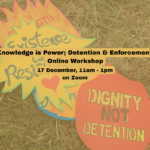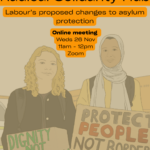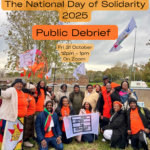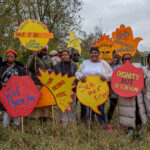This is the text of a talk given by Lisa Matthews of NCADC at the 2013 SOAS Detainee Support conference on Saturday 27 April. The panel was asked to consider:
What are the strategic opportunities and risks of advocating for ‘alternatives’ to detention? Should we be promoting existing ‘alternatives’ such as bail, or case management programmes involving engagement with migrants?
Immigration detention is wrong, and harmful. Detention destroys communities, and robs people of their lives, dignity and spirit.
We – those of us opposed to detention – are clear on this. We are clear it is morally wrong. We are clear it doesn’t work – it doesn’t act as a ‘deterrent’ to migrants coming to the UK, it doesn’t result in quick, efficient enforced removals of those the government have decided are undesirable. It costs huge amounts of money – it’s estimated that the UKBA spends some £110 per day or over £40,000 a year, per detainee.
We are clear the government locks migrants up to look ‘tough’ on immigration, to try and institutionalise the myth of difference between migrants and British citizens, to make it easier to hate migrants and to fear them and therefore to blame them for things that are wrong in the country.
We are clear that immigration detention must end, that all detention centres must close. But we are not clear how to get there.
This is why ‘alternatives’ to detention is such a prickly issue. If we are a long way from the end of detention altogether, what do we do in the meantime?
The International Detention Coalition, who have undertaken considerable worldwide research on the issue of alternatives to detention, define alternatives as: “any legislation, policy or practice that allows for asylum seekers, refugees and migrants to reside in the community with freedom of movement while their migration status is being resolved or while they await deportation or removal from the country”.
These might be release provisions, community models, or conditional release. The IDC has found, from surveying models of alternatives in different countries, that the benefits of alternatives can easily be evidenced – benefits for migrants, the government, for society. There are high rates of compliance (with the immigration system); they are cheaper than detention; human rights are protected; community integration for approved cases is improved. These ‘benefits’ are problematic for those of us who believe that immigration detention should never be used, however. Alternatives to detention shouldn’t just be a way of enforcement working better, but a step towards the end of enforcement altogether.
How can we use alternatives to detention strategically?
Alternatives to detention are an opportunity to start a discussion, to prove that detention doesn’t work, and that community engagement, with migrants, is the real alternative. For example, in the Netherlands, civil society groups came together under the coalition “No child in detention”. On 29 January 2008 the government publicised a new policy regarding the immigration detention of children and their families creating more alternative accommodation for them , and the improvement of detention conditions. After repeated calls by the coalition this was expanded to unaccompanied minors. In 2011, the Minister started investigating alternatives to detention for adults.
I am hesitant to use the ending of child detention as an example, because of the troubled history of that campaign in the UK – where the ‘victory’ of ending child detention has been co-opted by politicians, leading to the fracturing of the movement. Nevertheless, the Netherlands example still shows that starting on a small scale, with one group, can lead to an examination of how to end detention for everyone.
Decision makers, politicians – despite the tough act – are scared by the issue of immigration and even more so by enforcement. If they can see that resolving cases in the community works as in the example in the Netherlands, they are emboldened to tackle detention more broadly.
And it’s not just decision-makers. Using evidence of successful examples of community case management models as alternatives to detention is an opportunity to have a discussion about what detention is like. Most people have no idea, and may assume that detention is inevitable or justified. If you want to convince the public (whose support can provide a climate for politicians to make more positive policy on immigration) that detention isn’t the answer, you need to be able to suggest what the solution could be instead.
And we can never forget, when talking about alternatives to detention, and the detention system, that it’s about detainees, it’s about people. While we debate the opportunities and risks of detention alternatives – a necessary and vital debate – the daily reality is that alternatives to detention get people out of immigration removal centres, out of the ‘second torture’ of detention.
Risks of advocating for alternatives
With that reality check then, of recognising that for people in detention, alternatives are currently the only way they will be released unless they are granted leave to remain; no-one who cares about the well-being of others would deny the importance of that. But what are the risks of advocating for alternatives?
Improvements normalise a system we want to bring down – it is reform, not revolution. This is a tension in anti-enforcement advocacy in general – in the US, there are non-enforcement zones where migrants can’t be picked up and detained, including schools and children’s play-parks. Should we call for this in the UK, or does the shocking detention of families through dawn-raids and snatching kids from schools reveal how despicable enforcement is? A necessary truth to end enforcement? The same can be said by improving the behaviour of escort staff on removals – of course we want less terror, less assaults, but making enforcement less brutal is not our ultimate goal and can make the ending of enforcement harder to attain. These extremes of inhumanity shock us, and without that shock the general public may continue to accept a system of detention and forced removal that is by its very existence, violence against the individual and their freedom. By removing its excesses, do you provide life-support to the system?
The alternatives themselves leave a lot to be desired. Tagging and reporting are merely extensions of the deprivation of liberty beyond the walls of the prison. The very fact that we, almost unquestioningly, use the term ‘bail’ from the criminal justice system for a process that involves many individuals who have committed no crime at all, shows how even if someone is liberated from the physical detention of an immigration removal centre, they are not free from the language of detention and criminality.
Evidence on alternatives shows that there is increased sign-up for voluntary return (or more accurately, as Jerome has pointed out, ‘assisted return’) for refused cases – this is better than people signing up for ‘voluntary’ return because they cannot bear the mental torture of detention any longer – as we too often hear from detainees – but we must ensure that return is a choice made by an individual who is empowered and free to make a meaningful, safe choice. The use of the term ‘alternatives’ to describe projects by UKBA to try and encourage more people to return has muddied the waters in the sector. Like destitution, alternatives could all too easily be used as a coercive strategy to make people despair, to make people leave by any means possible.
But detention is too big a crime to be ignored, and alternatives too important a strategy to shy away from.
Is advocating for alternatives to detention in conflict with principled opposition to border control? Yes. But even if you are against immigration control and believe there should be no borders, like NCADC, you can still believe that advocating alternatives to detention is the right thing to do. It’s the right thing to do because of the opportunities I’ve mentioned, and because it’s essential for detainees. But we must acknowledge that conflict, that tension, and must not cease our calls for the end of all immigration detention whilst pressing for more, and better, alternatives.
We must make sure the alternatives are better and that they are used: detention has become the default, rather than the presumption of liberty, as is enshrined in law. Alternatives are a transitional demand, temporary relief for people in detention while we work together to end detention entirely.
Alternatives can distract from the bigger picture – and to us the bigger picture isn’t making sure that the existing system, with its mechanism for release from detention, is operated properly; but bringing that system down.
Advocating for alternatives to detention must not soften our determination to shine a light on the darkest aspects of the immigration system, and our commitment to end the outrage that is immigration detention.












Discussion: